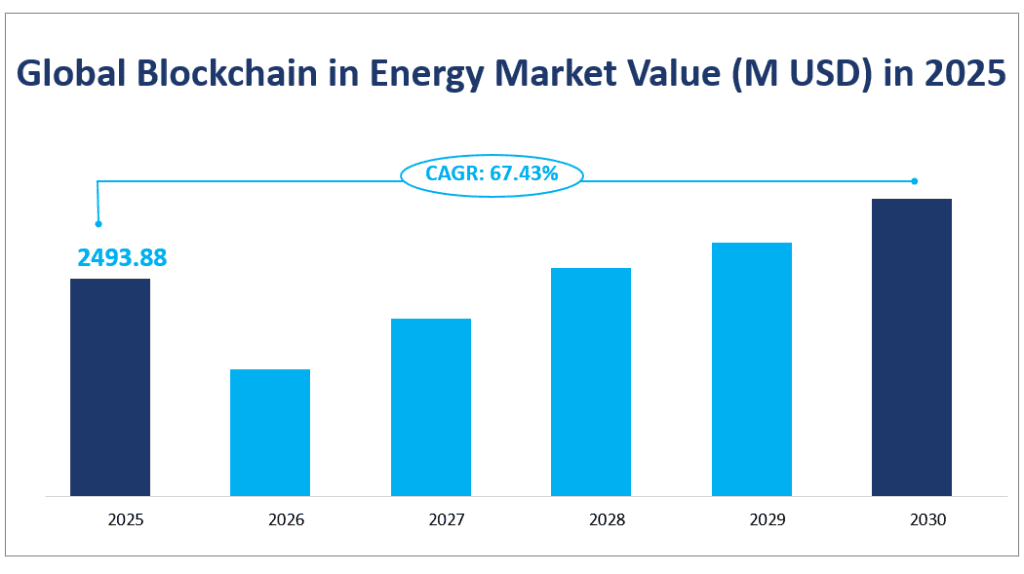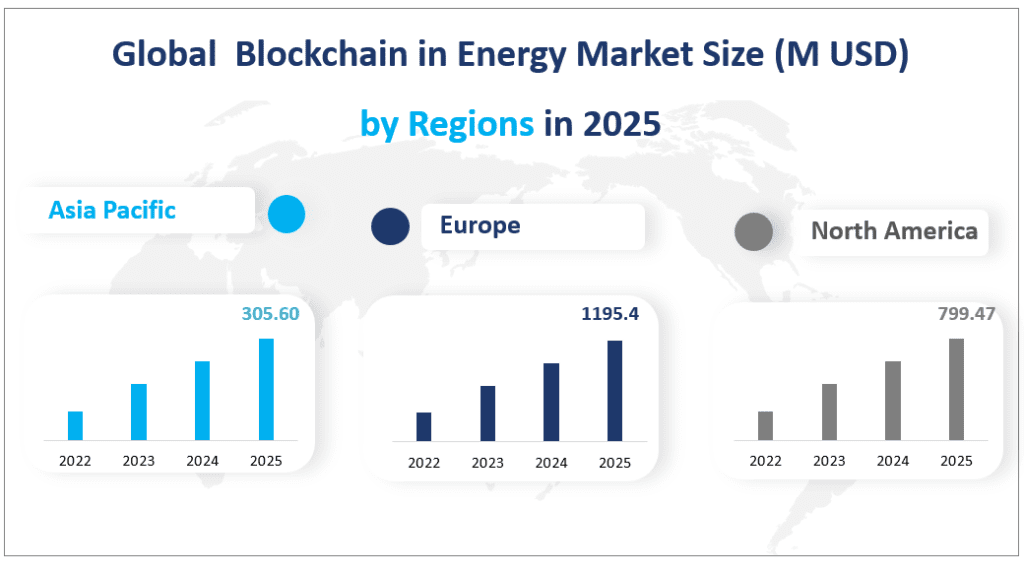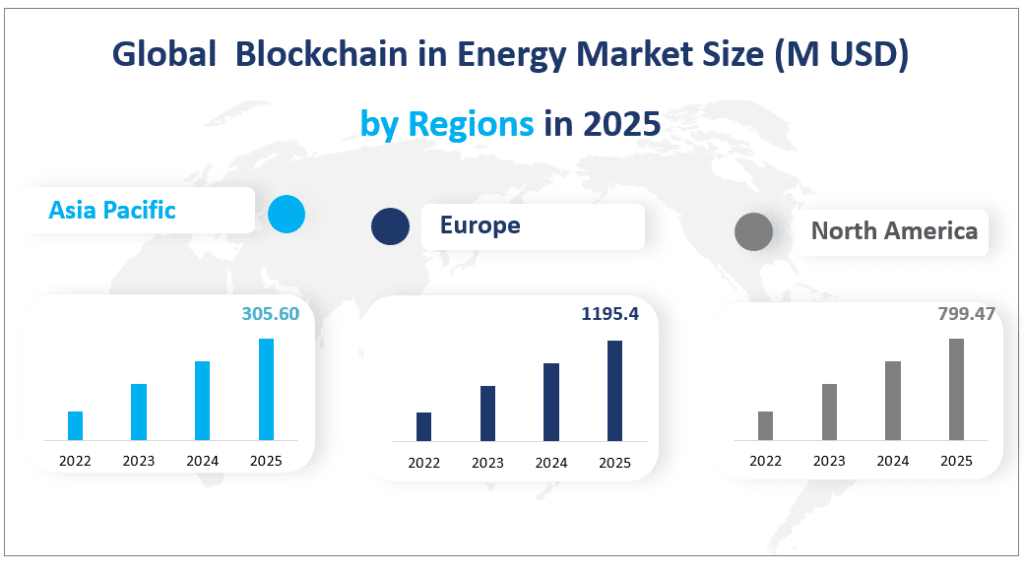1. Global Blockchain in Energy Market Overview
The global Blockchain in Energy market revenue is projected to reach $2,493.88 million in 2025 with a CAGR of 67.43% from 2025 to 2030.
This rapid expansion underscores the transformative potential of blockchain technology in optimizing energy systems, enhancing transparency, and fostering decentralized energy management.
Blockchain in Energy refers to the application of blockchain technology within the energy sector, aimed at improving the efficiency, security, and transparency of energy-related operations. Blockchain, a decentralized digital ledger, integrates various computer technologies such as distributed data storage, peer-to-peer transmission, consensus mechanisms, and encryption algorithms. Its core advantage lies in its ability to ensure data integrity, prevent tampering, and facilitate secure transactions without the need for intermediaries.
Global Blockchain in Energy Market Value (M USD) in 2025


2. Driving Factors of Blockchain in Energy Market
The growth of the Blockchain in Energy Market is propelled by several key factors. Firstly, the increasing demand for renewable energy sources and the need for efficient energy management systems are driving the adoption of blockchain technology. Blockchain enables the seamless integration of distributed energy resources, facilitating the transition to a more sustainable and resilient energy grid. This is particularly relevant as countries worldwide pursue ambitious renewable energy targets and seek to reduce carbon emissions.
Secondly, the inherent advantages of blockchain technology, such as enhanced security, transparency, and reduced transaction costs, are attracting energy companies and stakeholders. Blockchain’s ability to prevent data tampering and ensure the authenticity of energy transactions is crucial in an industry where data integrity is paramount. This not only improves operational efficiency but also builds trust among market participants.
Thirdly, the convergence of blockchain with other emerging technologies, such as the Internet of Things (IoT), artificial intelligence (AI), and big data, is creating new opportunities for innovation in the energy sector. These technologies can work synergistically to optimize energy consumption, predict demand patterns, and enhance grid management. For example, IoT devices can collect real-time energy usage data, which can be securely stored and analyzed using blockchain and AI algorithms to optimize energy distribution and reduce waste.
3. Limiting Factors of Blockchain in Energy Market
Despite its promising potential, the Blockchain in the Energy market faces several challenges that may limit its growth. One of the primary concerns is the issue of data security and privacy. While blockchain technology is designed to be secure, it is not immune to cyber-attacks. The potential for malicious code to be embedded in blockchain transactions poses a risk to the integrity of the energy grid. Additionally, the transparency of blockchain networks may lead to the inadvertent exposure of sensitive information, raising privacy concerns for energy consumers and businesses.
Another significant challenge is the technical complexity and scalability of blockchain solutions. The energy sector deals with vast amounts of data and requires high-speed transaction processing. Current blockchain technologies may struggle to meet these demands, leading to potential bottlenecks and inefficiencies. The need for continuous technological advancements and the development of more scalable blockchain solutions is crucial to overcoming these limitations.
Moreover, the lack of skilled professionals in the blockchain and energy sectors is a major bottleneck. Blockchain technology is highly technical and requires expertise in computer science, cryptography, and energy management. The shortage of qualified personnel to develop, implement, and maintain blockchain solutions in the energy sector may hinder the widespread adoption of this technology.
4. Blockchain in Energy Market Segment
Product Types
Among these types, Public Blockchain is expected to hold the largest market share in 2025, it is expected to generate $823.06 million in revenue, driven by its widespread adoption in applications such as peer-to-peer energy trading and renewable energy certification and accounting for approximately 33.00% of the total market revenue. Public Blockchain’s decentralized nature and transparency make it particularly suitable for applications such as peer-to-peer energy trading and electricity data management, where trust and accessibility are crucial.
Private Blockchain operates within a closed network, accessible only to authorized participants. It offers enhanced security and privacy, making it suitable for sensitive applications such as electricity data management and internal energy trading within organizations. By 2025, Private Blockchain is projected to generate $717.29 million in revenue. Its growth is driven by the increasing need for secure and efficient data management in the energy sector, particularly in areas where data privacy is paramount.
Hybrid Blockchain combines the features of both public and private blockchains, offering a flexible solution that balances transparency and control. It is particularly useful for applications that require both public accessibility and private security, such as smart grid management and renewable energy trading platforms. By 2025, Hybrid Blockchain is expected to generate $585.23 million in revenue.
Federated Blockchain, or consortium blockchain, is a semi-decentralized network managed by a group of pre-selected participants. It offers high performance and scalability while maintaining a high level of security. By 2025, Federated Blockchain is projected to generate $368.29 million in revenue.
Analysis of Different Applications
Among these applications, Peer-to-Peer Energy Trading is expected to hold the largest market share in 2025, accounting for approximately 31.12% of the total market revenue. This application leverages blockchain technology to enable direct energy trading between producers and consumers, eliminating intermediaries and reducing costs. The growth of peer-to-peer energy trading is driven by the increasing adoption of renewable energy sources and the need for more flexible and efficient energy markets.
Wholesale electricity distribution involves the large-scale trading of electricity between generators and retailers. By 2025, this application is projected to generate $584.93 million in revenue. Blockchain technology enables real-time monitoring and verification of electricity transactions, ensuring transparency and reducing the risk of fraud.
Peer-to-peer energy trading allows individuals and businesses to trade surplus energy directly with consumers, bypassing traditional intermediaries. By 2025, this application is expected to generate $776.01 million in revenue, holding the largest market share. The growth of peer-to-peer energy trading is driven by the increasing adoption of renewable energy sources, such as solar panels and wind turbines, which produce surplus energy that can be traded locally. Blockchain technology provides a secure and transparent platform for these transactions, reducing costs and enhancing efficiency.
Electricity data management involves the collection, storage, and analysis of energy usage data. By 2025, this application is projected to generate $490.12 million in revenue. Blockchain technology ensures the integrity and security of energy data, enabling accurate monitoring and optimization of energy consumption.
Commodity trading in the energy sector involves the trading of energy-related commodities such as oil, gas, and carbon credits. By 2025, this application is projected to generate $405.13 million in revenue. Blockchain technology enhances the transparency and efficiency of commodity trading by providing a secure and immutable ledger for transactions.
Market Revenue and Share by Segment
| Market Revenue (M USD) in 2025 | Market Share in 2025 | ||
| By Type | Public Blockchain | 823.06 | 33.00% |
| Private Blockchain | 717.29 | 28.76% | |
| Hybrid Blockchain | 585.23 | 23.47% | |
| Federated Blockchain | 368.29 | 14.77% | |
| By Application | Wholesale Electricity Distribution | 584.93 | 23.45% |
| Peer-to-Peer Energy Trading | 776.01 | 31.12% | |
| Electricity Data Management | 490.12 | 19.65% | |
| Commodity Trading | 405.13 | 16.25% | |
| Others | 237.68 | 9.53% |
5. Analysis of the Blockchain in Energy Market Size by Major Regions in 2025
North America is a significant market for Blockchain in Energy, projected to generate $799.47 million by 2025. The region’s growth is driven by the United States and Canada, which are actively exploring blockchain solutions for energy management, peer-to-peer trading, and data security. The presence of major technology companies and a supportive regulatory environment further fuel the adoption of blockchain in the energy sector. North America’s market share is expected to remain robust, driven by continuous innovation and investment in blockchain technologies.
Europe is the largest regional market for Blockchain in Energy, with a projected revenue of $1,195.42 million by 2025. The region’s dominance is attributed to its advanced technological infrastructure, supportive regulatory frameworks, and the presence of key industry players. European countries are leading the way in integrating blockchain with renewable energy projects, smart grids, and energy trading platforms. The European Union’s commitment to reducing carbon emissions and promoting sustainable energy solutions further drives the adoption of blockchain technologies in the region.
The Asia-Pacific region is the fastest-growing market for Blockchain in Energy, the region is projected to generate $305.60 million in 2025 in revenue. The growth is driven by countries like China, Japan, and South Korea, which are investing heavily in blockchain and renewable energy technologies. The region’s rapid urbanization, increasing energy demand, and focus on sustainability are key factors driving the adoption of blockchain in energy management and trading. The Asia-Pacific region is poised to become a major player in the global Blockchain Energy market.
South America is projected to generate $108.12 million in revenue by 2025. South America’s market is expected to grow steadily, driven by increasing investment in smart grid technologies and the need for efficient energy management systems. The Middle East and Africa region is projected to generate $85.27 million by 2025. The region’s market is expected to grow steadily, driven by increasing demand for sustainable energy solutions and the need for efficient energy distribution systems.
Global Blockchain in Energy Market Size (M USD) by Regions in 2025


6. Analysis of the Top 3 Companies in the Blockchain in Energy Market
Company Introduction and Business Overview
SAP is a leading multinational software company headquartered in Germany. Established in 1972, SAP is renowned for its enterprise resource planning (ERP) solutions and business software. The company aims to help businesses of all sizes and industries achieve operational excellence and sustainable growth. SAP’s solutions span various sectors, including energy, where it leverages blockchain technology to enhance energy management and sustainability.
Products Offered
SAP offers a range of blockchain-based solutions for the energy sector, including:
Energy Monitoring and Analysis: Tools for real-time monitoring of energy usage and generation.
Sustainability Assessment: Solutions for assessing the environmental impact of energy projects.
Quality Management and Compliance: Tools for ensuring compliance with regulatory standards in the energy sector.
Company Introduction and Business Overview
Acciona is a global infrastructure and renewable energy company headquartered in Spain. Established in 1997, Acciona focuses on sustainable infrastructure solutions, particularly in the renewable energy sector. The company operates across the entire value chain, from design and construction to operation and maintenance. Acciona is committed to leveraging blockchain technology to enhance transparency and efficiency in energy projects.
Products Offered
Acciona offers several blockchain-based products and solutions, including:
Greenchain: A platform that ensures the traceability of renewable energy sources and provides real-time data to consumers.
ATHERMIS®: Software for thermographic inspection of photovoltaic modules in large solar plants.
ADOSA STORAGE®: A tool for analyzing and simulating storage systems in renewable energy plants.
Company Introduction and Business Overview
Powerledger is an Australian software and technology company founded in 2016. The company specializes in developing blockchain-based energy applications, particularly for peer-to-peer energy trading. Powerledger aims to make renewable energy more accessible and efficient by leveraging blockchain technology to create transparent and auditable energy markets.
Products Offered
Powerledger offers several blockchain-based products, including:
P2P Energy Trading Platform: A platform that allows renewable energy asset owners to sell surplus energy directly to consumers.
Energy Management Solutions: Tools for managing energy consumption and distribution in residential and commercial settings.
Major Players
| Company | Sales Regions |
| SAP | Worldwide |
| Acciona | Worldwide |
| Powerledger | Worldwide |
| WePower | Mainly in Europe |
| Everledger | Worldwide |
| Energy Web | Worldwide |
| Suncontract | Mainly in Europe |
| Greeneum | Mainly in Europe, North America |
| C4E DAO AG | Mainly in Europe |
1 Market Overview
1.1 Product Overview and Scope of Blockchain in Energy
1.2 Classification of Blockchain in Energy by Type
1.2.1 Overview: Global Blockchain in Energy Market Size by Type: 2017 Versus 2021 Versus 2028
1.2.2 Global Blockchain in Energy Revenue Market Share by Type in 2021
1.3 Global Blockchain in Energy Market by Applications
1.3.1 Overview: Global Blockchain in Energy Market Size by Application: 2017 Versus 2021 Versus 2028
1.4 Global Blockchain in Energy Market Size & Forecast
1.5 Global Blockchain in Energy Market Size and Forecast by Region
1.5.1 Global Blockchain in Energy Market Size by Region: 2017 VS 2021 VS 2028
1.5.2 Global Blockchain in Energy Market Size by Region, (2017-2028)
1.5.3 North America Blockchain in Energy Status and Prospect (2017-2028)
1.5.4 Europe Blockchain in Energy Status and Prospect (2017-2028)
1.5.5 Asia-Pacific Blockchain in Energy Status and Prospect (2017-2028)
1.5.6 South America Blockchain in Energy Status and Prospect (2017-2028)
1.5.7 Middle East and Africa Blockchain in Energy Status and Prospect (2017-2028)
1.6 Market Drivers, Restraints and Trends
1.6.1 Blockchain in Energy Market Drivers
1.6.2 Blockchain in Energy Market Restraints
1.6.3 Blockchain in Energy Trends Analysis
2 Company Profiles
2.1 SAP
2.1.1 SAP Details
2.1.2 SAP Major Business
2.1.3 SAP Blockchain in Energy Product and Solutions
2.1.4 SAP Blockchain in Energy Value, Gross Margin and Market Share (2019-2022)
2.1.5 SAP Recent Developments and Future Plans
2.2 Acciona
2.2.1 Acciona Details
2.2.2 Acciona Major Business
2.2.3 Acciona Blockchain in Energy Product and Solutions
2.2.4 Acciona Blockchain in Energy Value, Gross Margin and Market Share (2019-2022)
2.2.5 Acciona Recent Developments and Future Plans
2.3 Powerledger
2.3.1 Powerledger Details
2.3.2 Powerledger Major Business
2.3.3 Powerledger Blockchain in Energy Product and Solutions
2.3.4 Powerledger Blockchain in Energy Value, Gross Margin and Market Share (2019-2022)
2.3.5 Powerledger Recent Developments and Future Plans
2.4 WePower
2.4.1 WePower Details
2.4.2 WePower Major Business
2.4.3 WePower Blockchain in Energy Product and Solutions
2.4.4 WePower Blockchain in Energy Value, Gross Margin and Market Share (2019-2022)
2.5 Everledger
2.5.1 Everledger Details
2.5.2 Everledger Major Business
2.5.3 Everledger Blockchain in Energy Product and Solutions
2.5.4 Everledger Blockchain in Energy Value, Gross Margin and Market Share (2019-2022)
2.6 Energy Web
2.6.1 Energy Web Details
2.6.2 Energy Web Major Business
2.6.3 Energy Web Blockchain in Energy Product and Solutions
2.6.4 Energy Web Recent Developments and Future Plans
2.7 Suncontract
2.7.1 Suncontract Details
2.7.2 Suncontract Major Business
2.7.3 Suncontract Blockchain in Energy Product and Solutions
2.7.4 Suncontract Blockchain in Energy Value, Gross Margin and Market Share (2019-2022)
2.7.5 Suncontract Recent Developments and Future Plans
2.8 Greeneum
2.8.1 Greeneum Details
2.8.2 Greeneum Major Business
2.8.3 Greeneum Blockchain in Energy Product and Solutions
2.8.4 Greeneum Blockchain in Energy Value, Gross Margin and Market Share (2019-2022)
2.9 C4E DAO AG
2.9.1 C4E DAO AG Details
2.9.2 C4E DAO AG Major Business
2.9.3 C4E DAO AG Blockchain in Energy Product and Solutions
2.9.4 C4E DAO AG Blockchain in Energy Value, Gross Margin and Market Share (2021-2022)
3 Market Competition, by Players
3.1 Global Blockchain in Energy Revenue and Share by Players (2019-2022)
3.2 Market Concentration Rate
3.2.1 Top 3 Blockchain in Energy Players Market Share in 2021
3.2.2 Top 6 Blockchain in Energy Players Market Share in 2021
3.3 Blockchain in Energy Players Head Office, Sales Regions
3.4 Mergers & Acquisitions, Expansion
4 Market Size Segment by Type
4.1 Global Blockchain in Energy Revenue and Market Share by Type (2017-2022)
4.2 Global Blockchain in Energy Market Forecast by Type (2022-2028)
5 Market Size Segment by Application
5.1 Global Blockchain in Energy Revenue Market Share by Applications (2017-2022)
5.2 Blockchain in Energy Market Forecast by Applications (2022-2028)
6 North America Blockchain in Energy Revenue by Countries, by Type, and by Application
6.1 North America Blockchain in Energy Revenue and Market Share by Type (2017-2028)
6.2 North America Blockchain in Energy Revenue Market Share by Applications (2017-2028)
6.3 North America Blockchain in Energy Revenue by Countries (2017-2028)
6.3.1 North America Blockchain in Energy Revenue by Countries (2017-2028)
6.3.2 United States Blockchain in Energy Revenue and Growth Rate (2017-2028)
6.3.3 Canada Blockchain in Energy Revenue and Growth Rate (2017-2028)
6.3.4 Mexico Blockchain in Energy Revenue and Growth Rate (2017-2028)
7 Europe Blockchain in Energy Revenue by Countries, by Type, and by Application
7.1 Europe Blockchain in Energy Revenue and Market Share by Type (2017-2028)
7.2 Europe Blockchain in Energy Revenue Market Share by Applications (2017-2028)
7.3 Europe Blockchain in Energy Revenue by Countries (2017-2028)
7.3.1 Europe Blockchain in Energy Revenue by Countries (2017-2028)
7.3.2 Germany Blockchain in Energy Revenue and Growth Rate (2017-2028)
7.3.3 France Blockchain in Energy Revenue and Growth Rate (2017-2028)
7.3.4 United Kingdom Blockchain in Energy Revenue and Growth Rate (2017-2028)
7.3.5 Russia Blockchain in Energy Revenue and Growth Rate (2017-2028)
7.3.6 Italy Blockchain in Energy Revenue and Growth Rate (2017-2028)
11 Research Findings and Conclusion
12 Appendix
12.1 Methodology
12.2 Research Data Source
12.2.1 Secondary Data
12.2.2 Primary Data
12.2.3 Market Size Estimation
12.2.4 Legal Disclaimer
12.2.5 Unit Explanation in This Report
